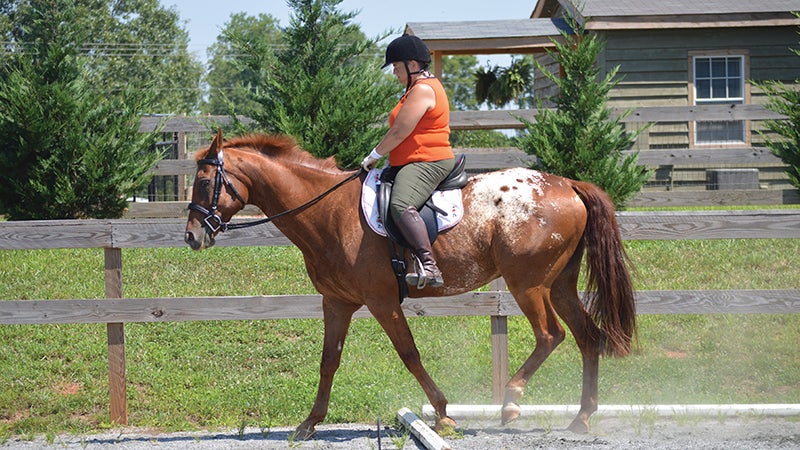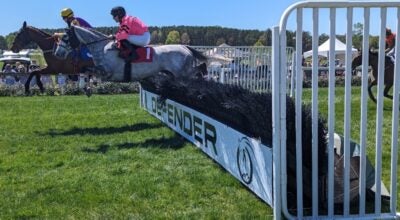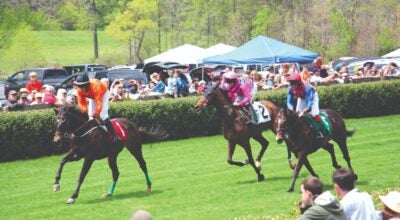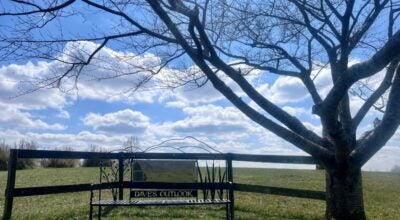Buying your first horse
Published 9:47 am Monday, August 6, 2018

- When considering size, look for a horse that is suited to your height and weight. Courtesy of Harmony Training LLC
This is the sixth in a series of articles to help prospective new horse owners increase their chances of successful horse ownership.
I broke all the rules when I bought my first horse.
I was 15 years old and bought a 2-year-old Thoroughbred filly that had never been handled — at an auction. In fact, I had never seen her up close before we bid.
I had been saving my babysitting money for years and, like so many, this was my dream horse. Unlike most first-time buyers, I had years of experience, not only riding, but breaking and training as well.
Because of this knowledge and experience, and the support of an accomplished instructor/trainer, my first horse buying experience turned out very well.
Unfortunately for so many, their first horse buying experience turns out much differently — even becoming a nightmare for some.
Most experienced horsemen and women have seen the heartbreaking accidents, the dreams that wind up in the dust or worse. We see the horses sold at half their worth or to a kill buyer simply because the new owner either bought too much horse or too green a horse.
However, there are ways to avoid such disasters and make an investment in an equine that will give you years, even decades, of safe, fun and satisfying enjoyment.
One of the most important, and perhaps the most difficult, things to do when it comes to purchasing that first horse is to buy with your head, not your heart.
Use your head,
not your heart
Buying a horse can be a very emotional experience.
Most people who are in the process of purchasing their first mount have been dreaming about that horse for years — possibly since childhood.
They have imagined themselves blissfully galloping down tails on a beautiful Arabian or Thoroughbred, its mane flowing in the wind. Perhaps they have dreamed of the championship ribbons they would win, or how all the books and movies show the special bond that happens between the gifted rider and the perfect horse.
Regardless, when any of us buys a horse, we are not buying flesh and blood, we are buying dreams.
However, when you open up that wallet or write that check, it is good to remember this is a commitment, for better or worse, for years, even decades. Not only is it a commitment, you are literally taking your life and limb in your hands.
With that in mind, do your homework.
Call on a team of qualified experts for help. Take along a reputable trainer when you think you have found the right horse. Go look at the horse more than once to see if the horse’s behavior is consistent.
Most importantly, be sure the horse is suitable for your level of riding ability and for the type of riding you wish to pursue. Unfortunately, so many people simply buy a horse because they fall in love with it or because it is beautiful — regardless of whether or not they can successfully ride or even handle the animal.
Training
Just because the horse is a highly trained show horse with lots of trophies doesn’t mean it is right for everyone.
A well-trained fourth-level dressage horse or an experienced cow horse are usually much too sensitive and highly trained for a new rider.
I have seen so many new horse owners give up the sport because they bought a show ring winner or time event horse, only to realize the horse was too sensitive to be tolerant of the unavoidable mistakes made by inexperienced riders. Such a horse often reacts correctly and very swiftly, surprising an unprepared rider.
If you have been taking lessons for a few months to learn a good functional seat, you will want to look for a horse that is trained to an advanced beginner or low-intermediate level. Such a horse is quiet and tolerant, but still has enough spirit and energy so you will not become bored in a year or two.
Be cautious of a horse that “anyone can ride” or that appears to have no interest in things going on around them. Horses that are drugged, unhealthy or sore can change into a completely different animal once they are healthy, sound and drug free.
If the horse has not been overused in a training program, a former lesson horse is a good option. Look for one that responds readily to your signals without over reacting. The horse should also be somewhat patient and tolerant, especially if you are not a strong rider.
Former show horses that are older and no longer competing sometimes make ideal first horses. They have a lot of knowledge to teach a novice rider. However, it is important to be careful that the horse is not still so sensitive it reacts to unconscious movements.
Look for a horse that is trained in the discipline of riding you wish to pursue. If you want to trail ride, be certain the horse is experienced on trails.
Some show horses are not good outside of a ring, are easily spooked on the trails or will not cross water or bridges.
If you wish to jump or hunt, be sure the horse is trained for jumping. A show jumper or barrel horse is not trained for dressage, and a dressage horse may not be ideal for a timed event horse.
If you are looking for a hunter or trail horse, be sure the horse is quiet and easy to ride in the company of other horses. Also a good trail or hunter should be comfortable following other horses or riding in the center of the group.
If you wish to try driving, look for a horse that is broke to pull a wagon or carriage. Just because the horse pulls farm equipment or a sled does not mean it can handle a wagon, cart or carriage. Unless you are purchasing a team, be sure the horse is trained to pull single.
As always, talk with your trainer about what they see in the horse’s training level.
Health and soundness
A good trainer can rule out a lot of health and soundness issues that are readily evident.
Obviously, if the horse is limping, has a lot of mucus draining from its nose or is coughing a lot more than would be justified by dust, the horse is most likely too big of a risk, especially for a first-time horse owner.
A good trainer with a discriminating eye can spot many hidden lameness issues such as stifle or hock problems, ringbone, founder, a bowed tendon, etc. It is always smart to have the horse vetted, including x-rays, by a qualified veterinarian before purchase.
Plan to spend a few hundred on such an exam; it could save you thousands in the long run.
Gender
Gender is not nearly so important, as the simple fact that a stallion (an intact male horse) is not a suitable first-time horse.
A gelding is a neutered male horse and, because they are much quieter and easier to handle, are much more suitable for a novice rider.
Movies and TV have made “taming a wild stallion” seem romantic and even easy, however, quite the opposite is true. No matter how well-behaved, stallions take a lot of skill and experience to handle.
Anyone owning a stallion takes on the liability of keeping the other horses and riders around them safe from the horse’s aggressive behavior. Though many stallions can be ridden around other horses, including mares, it only takes a moment for things to escalate dangerously past the ability of most novices to control.
In addition, stallions have to be stabled and/or pastured separately from other horses and many events and groups will not allow stallions to participate. Ownership of stallions is best left to the experts who invest in them as breeding stock rather than pleasure horses.
Age
More people make the mistake of buying a horse too young than one too old.
The sad story of parents buying a yearling colt so it and their child can “grow up together” much too often leads to an injured child or a horse being whisked off to the killer sale by an upset parent.
Horses are not considered adult until they reach the age of at least 5 years old. Some breeds mature more slowly and live longer. Imagine the bouncy, playful immaturity of a 6-week, even a 6-month-old puppy, then multiply that by 100 or more times and add hooves.
Most trainers consider 5 year olds and under as much too immature for a novice rider. Unless the horse is exceptional, most good trainers prefer to mount novice riders on something at least 7 or 8 years old.
Older horses are great for teaching new riders. They usually understand what is expected of them and do not require perfect signals in order to interpret the rider’s wishes. Older horses are often more tolerant than a young horse and will be less quickly to overreact.
Today, horses are living longer and staying sound longer than any time throughout history. Therefore, when looking for a novice’s first horse, many trainers consider horses between the ages of 7 and 12, or even 15 years old. Depending on the rider and the individual horse, they may even shop for a horse up to 18 years or more.
Size
So many first time horse owners make the mistake of buying a horse that is too big for them.
Whether they are concerned about the horse’s ability to carry their weight, or it makes them feel better mounted, it is simply difficult to mount and handle a horse that is much taller than your reach.
When considering size, it is important to remember that you will have to be able to reach the top of the horse’s back to brush and saddle it, and will have to be able to reach the top of the horse’s head to put on a halter, a bridle or to brush and care for the horse’s ears, eyes, etc.
A good estimate of size most people go by is that a horse can carry approximately 20 percent of its body weight — including the saddle and blankets. Therefore, an average size horse that weighs about 1,200 pounds can carry approximately 240 pounds of rider and tack.
When considering size, you will also want to consider how you look on the horse. A 5-foot woman will look “over mounted” on a 17 hand Warmblood and a 6 foot, 3 inch man will look under mounted on a 15 hand Morgan.
One last thing to think about when looking at size is, unless you are handicapped, can you mount from the ground?
This is important because you never know when you may have to dismount and there is not a mounting block or a friendly rock around.
Where to look
As mentioned earlier, a horse auction is not the best place to find your dream horse.
There are many online sites listing horses for sale in your area. Many of these sites will include information about the horse’s temperament, training level, manners, etc. You can filter your search to only look for horses with specifics that fit your needs.
Another good source may be a friend who recently purchased a horse they are very happy with — and ride frequently. If they purchased from a reputable trainer who trains and sells, this could be a good source.
Of course, ask your trainer, but be careful of a trainer who will quickly talk you out of considering any horse that is not in his or her barn. Your trainer may know of a private party whose child has gone to college and cannot take the horse, or someone who is moving on to a more challenging mount.
Though you typically want to stay away from “horse dealers,” there are many reputable trainers who train horses specifically for sale as part of their income.
Adoption
Many new to the horse industry consider adopting a “rescue” horse in an effort to save money on the purchase price.
Like so many things, you get what you pay for. Adoption can become very costly in the long run as the new owner tries to deal with lack of training, temperament problems or health issues.
People don’t give away sound, healthy, well-trained horses.
Most reputable equine rescues will carefully vet a prospective owner to be sure you have the knowledge and experience to care for, what could be a “special needs” horse. Be very cautious of organizations that do not “vet” prospective owners and are ready to give you a horse too quickly.
While most rescue organizations are well managed, some take on more than they can handle and are desperate to find someone to take the stock off their hands.
Though books and movies make adopting a “wild Mustang” sound romantic, it is a very good way for a novice to get badly hurt. These horses are young, wild and scared.
They perceive humans as predators and will stop at nothing to escape — including running over top of you or kicking you to death. Leave adopting a rescue or a wild horse to the experts who have the skills and expertise to solve the problems or break and train the horse properly.
Most of all, in looking for that first horse, take your time. My mother, Gigi Holescher, who was also my first trainer, used to say, “Never buy the first horse you see.” What she was saying is there are a lot of horses for sale.
You will be essentially married to this horse for years, maybe even tens of years. It is worth the time it will take to find the right one.
Next month, Foothills Magazine will go into greater details about the traits of popular breeds and matching the care needs of the individual horse to your lifestyle and pocketbook.
Catherine Hunter’s journalism career spans 20 years of writing for newspapers and magazines, including The Chronicle of the Horse, The Western Horseman, the Tryon Daily Bulletin and Foothills Magazine. In 2000, Hunter received a South Carolina Press Association award for reporting in depth. She is the author of “Sacred Connections Horsemanship: Empowering Horse and Rider through Chakra Energy.” Email her at catherine.hunter@tryondailybulletin.com.





